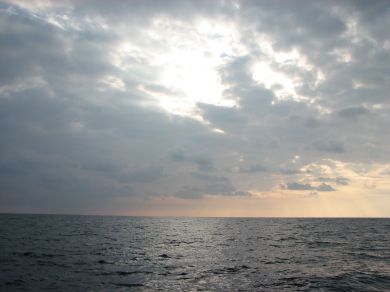
Mercury in the oceans as a whole has increased roughly 10 percent over pre-industrial times. Photo courtesy of Karl Griswold.
Little was known about how much mercury in the environment was the result of human activities, or how much “bioavailable” mercury was in the world’s oceans. Until now.
The first direct calculation of mercury pollution in the world’s oceans, based on data from 12 oceanographic sampling cruises during the last eight years, is reported in this week’s issue of the journal Nature.
The scientists involved are affiliated with the Woods Hole Oceanographic Institution (WHOI) in Massachusetts, Wright State University in Ohio, the Observatoire Midi-Pyréneés in France and the Royal Netherlands Institute for Sea Research in the Netherlands.
The research was funded by the National Science Foundation (NSF) and the European Research Council. It was led by WHOI marine chemist Carl Lamborg. The results offer a look at the global distribution of mercury in the marine environment.
“Mercury is an environmental poison that’s detectable wherever we look for it, including the ocean abyss,” says Don Rice, director of the NSF’s Chemical Oceanography Program.
“These scientists have reminded us that the problem is far from abatement, especially in regions of the world’s oceans where the human fingerprint is most distinct.”
Mercury is a naturally occurring element as well as a by-product of such human activities as burning coal and making cement.
“If we want to regulate mercury emissions into the environment and in the food we eat, we should first know how much is there and how much human activity is adding every year,” says Lamborg.
“At the moment, however, there is no way to look at a water sample and tell the difference between mercury that came from pollution and mercury that came from natural sources. Now we at least have a way to separate the bulk contributions of natural and human sources over time.”
The group started by looking at data that reveal details about ocean levels of phosphate, a substance that is better studied in the oceans than mercury and that behaves in much the same way as mercury.
Phosphate is a nutrient that, like mercury, is taken up into the marine food web by binding with organic material.
By determining the ratio of phosphate-to-mercury in water deeper than 1,000 meters (3,300 feet) that has not been in contact with Earth’s atmosphere since the Industrial Revolution, the researchers were able to estimate mercury in the oceans that originated from natural sources such as the breakdown, or weathering, of rocks on land.
Their findings agreed with what they would expect to see given the pattern of global ocean circulation.
North Atlantic waters, for example, showed the most obvious signs of mercury pollution because that’s where surface waters sink to form deep and intermediate water flows.
The tropical and Northeast Pacific, on the other hand, were relatively unaffected; it takes centuries for deep ocean water to circulate to these regions.
Determining the contribution of mercury from human activity required another step.
To obtain estimates for shallower waters and to provide numbers for the amount of mercury in the oceans, the scientists needed a tracer–a substance that could be linked with major human activities that release mercury into the environment.
They found it in one of the most well-studied gases of the past 40 years: carbon dioxide. Databases containing information on carbon dioxide in ocean waters are extensive and readily available for every ocean at all depths.
Because much of the mercury and carbon dioxide from human sources comes from the same activities, the team was able to derive with an index relating the two.
The results show that the oceans contain about 60,000 to 80,000 tons of mercury pollution.
Ocean waters shallower than about 100 meters (300 feet) have tripled in mercury concentration since the Industrial Revolution. Mercury in the oceans as a whole has increased roughly 10 percent over pre-industrial times.
“The next 50 years could very well add the same amount we’ve seen in the past 150,” says Lamborg.
“We don’t know what that means for fish and marine mammals, but likely that some fish contain at least three times more mercury than 150 years ago. It could be more.
“The key is that now we have some solid numbers on which to base continued work.”
